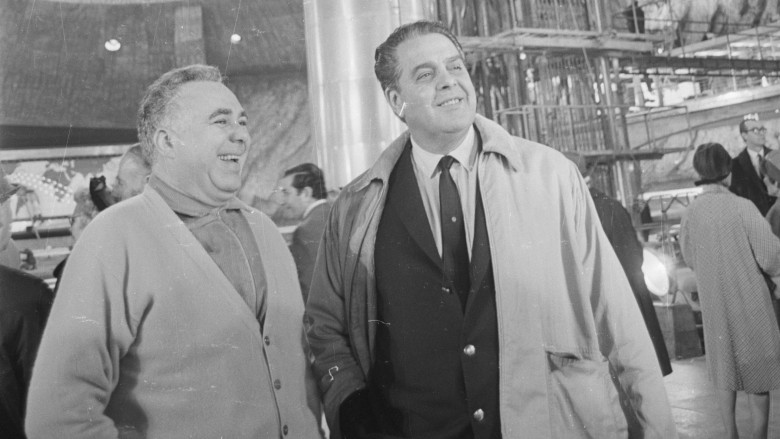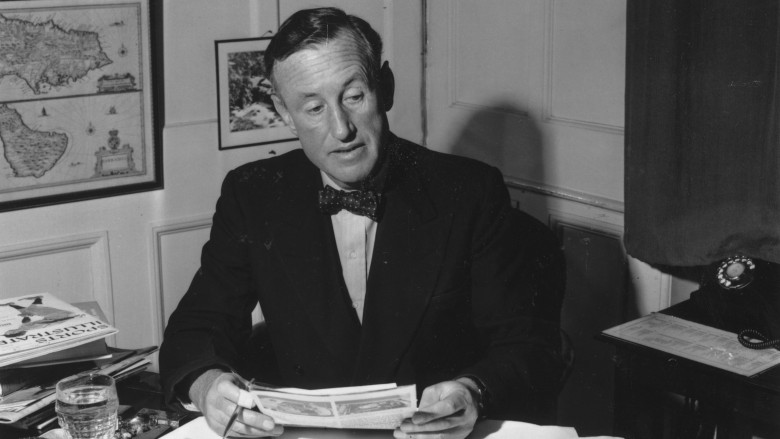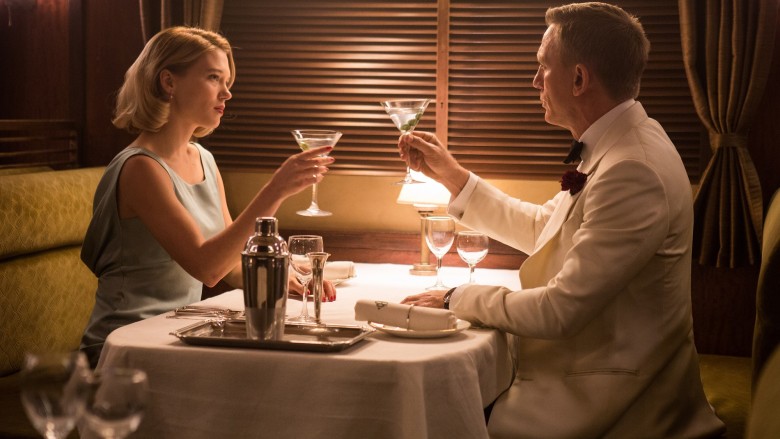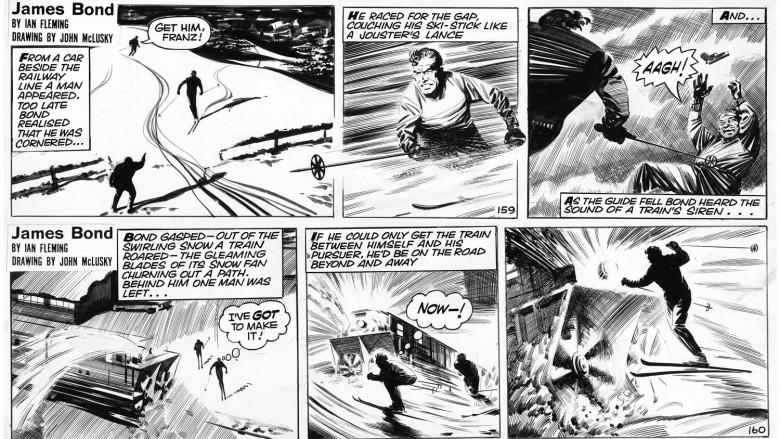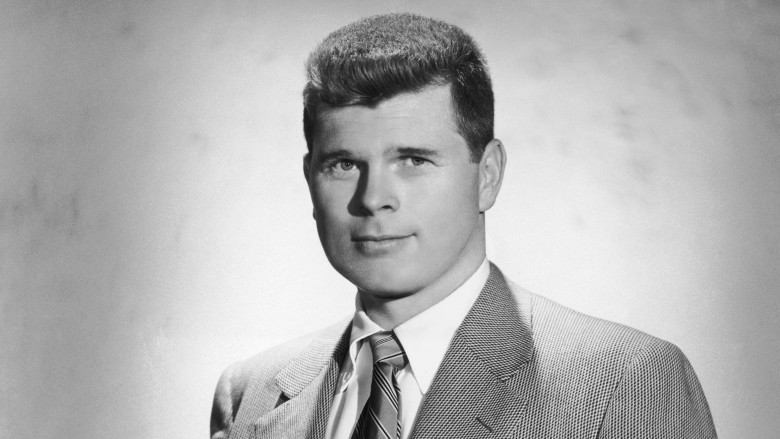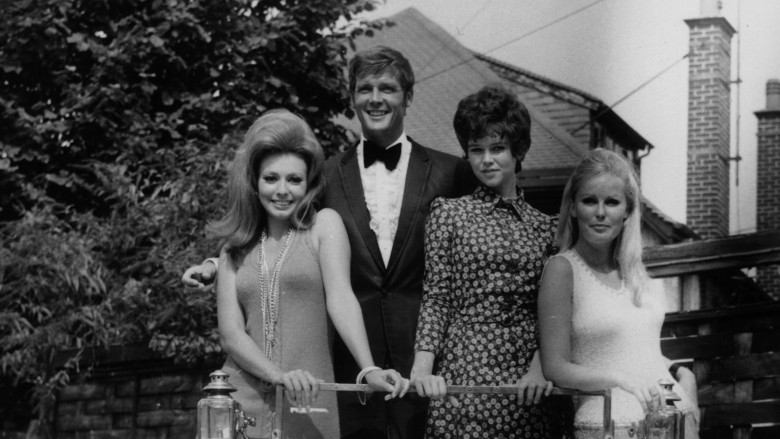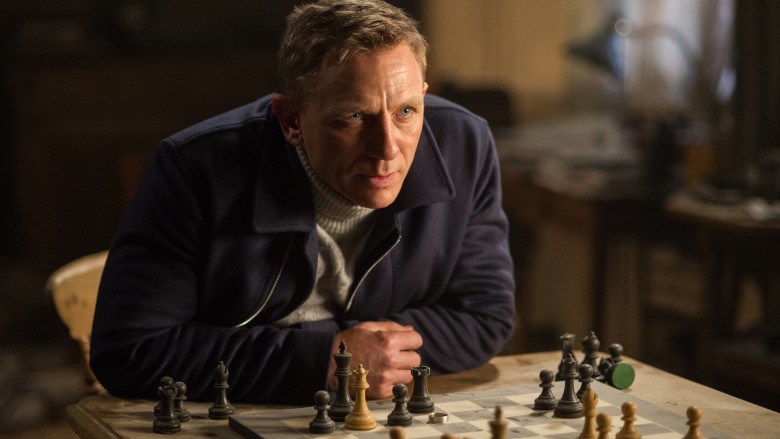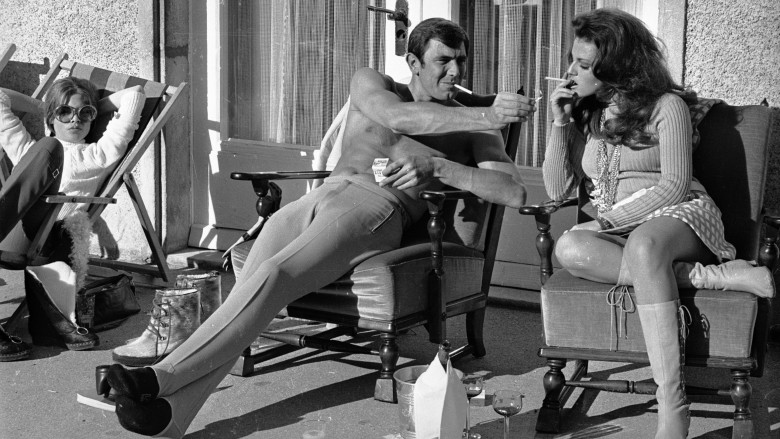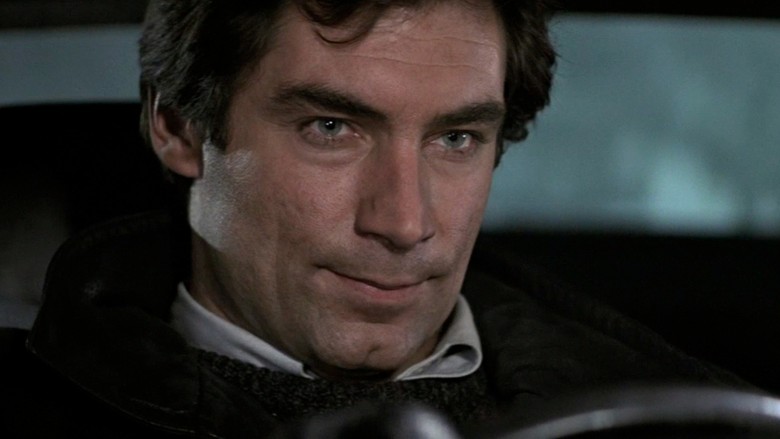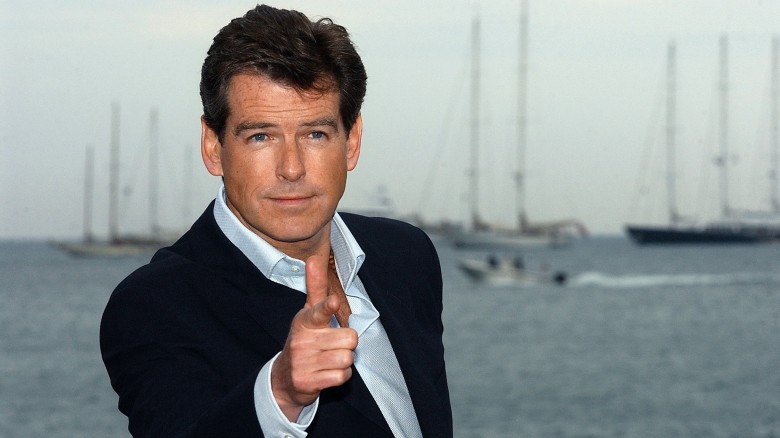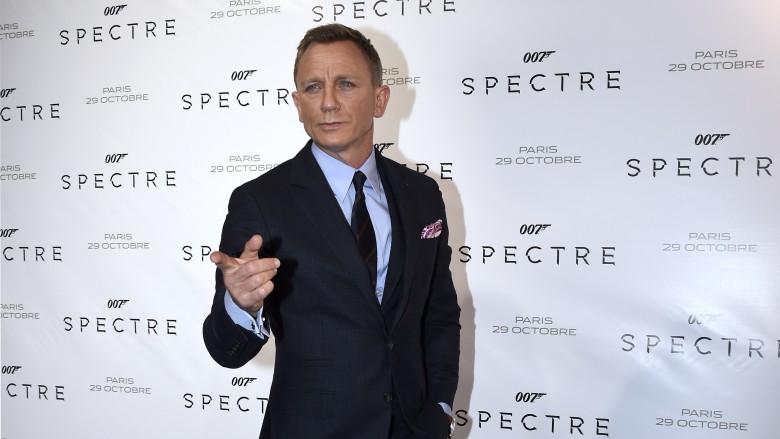The Untold Truth Of James Bond
Though times have changed since the first James Bond novel hit the shelves in 1953, 007's popularity has never waned. With over 60 years of history, there's a lot you probably don't know about your favorite British spy. So shake up your martini and get ready to learn the untold truth of James Bond.
The movies were brought to life by a broccoli farmer
Growing up in New York, Albert "Cubby" Broccoli (pictured to the right) worked on his uncle's farm, which featured the family's signature vegetable, broccoli. However, Cubby didn't want to spend his entire life working in the dirt, so he went to Hollywood in the 1930s, and after slowly working his way up, he co-produced the first Bond film. During his search for the titular hero, Broccoli heard an actor named Sean Connery might be a good choice, so he went to see the Scotsman in Darby O'Gill and the Little People. Broccoli was impressed with Connery's work on the leprechaun movie, but wondering if the actor had the sex appeal needed for Bond, Broccoli showed his wife the film. She made it clear that he had sexiness to spare. Though movie studio United Artists threw around a lot of names, Broccoli fought for Connery to play the role, and so began one of the longest running film series in history.
Ian Fleming shamelessly promoted his books
Before there were the movies, there were the novels. Written by Ian Fleming, the 14 Bond books were sort of a fantasy version of Fleming's real-life experiences as a member of British Naval Intelligence. However, the author was totally unknown when Casino Royale was set to be published, but he was determined to make the book a hit. His advertising game plan involved sending letters to newspaper editors (complete with a signed copy of the book), and he even reached out to author Somerset Maugham. The respected writer wrote back to Fleming, saying he'd greatly enjoyed the novel, but when Fleming asked if his kind words could be used to publicize the story, Maugham replied with a swift "no." Still, Fleming wasn't a guy who gave up, and when the book landed a publishing deal in America, he pushed even harder. The man wrote to any friend he could, trying to get into Vogue or Time or anything that would get his name out.
Despite his efforts, the books still weren't selling well, especially in America, but everything changed when Fleming met an old, deteriorating Raymond Chandler. Despite Chandler's poor health, Fleming still asked the mystery writer to promote his novel. But Fleming took things even further when the prime minister of Great Britain fell ill. Sick from the strain after the Suez Crisis, Anthony Eden needed a place to relax. Always one to grab an opportunity, Fleming eagerly gave the politician access to his secluded home in Jamaica, a little getaway that Fleming called "Goldeneye." However, the place didn't have a telephone, hot water, or a bathroom. Even worse, there were rats running around the roof. It wasn't exactly a great place for an ill man, but Fleming was thrilled by the visit, hoping Eden's stay at Goldeneye would boost his "American sales." And believe it or not, the crazy publicity stunt worked, thrusting Fleming into the public eye.
Bond really loves his food
When you think of James Bond's quirks, you probably don't think of him as a foodie. But in the books, this British super spy was a regular gourmand. Luxurious meals described in painstaking detail were just as much a part of the fantasy for the British public as the sex and espionage.
Fleming felt the food transported readers into the novels' exotic locations. He gave Bond extravagant tastes, letting the double agent feast on stone crabs and a meat called "brizzola." But at the end of the day, it's understandable why Bond's gastronomical compulsions were left out of the films. Hearing Bond obsesses over shellfish isn't quite as cool as seeing him order his martinis a particular way.
The James Bond comic strip
Before Dr. No hit theaters in 1962, it was actually possible to see the adventures of James Bond, six days a week. Only instead of visiting a theater, you had to pick up a copy of the Daily Express, instead. From 1958 to 1966, artist John McLusky drew a 007 comic strip, giving Bond a more modern look instead of the staid '30s image Fleming originally wanted. Oddly enough, the comic character looked a lot like Sean Connery, even though it was drawn before the actor was a well-known star. However, perhaps Connery had subliminally influenced McLusky's illustrations. In a strange twist of fate, one of the artist's skiing buddies was Leslie Linder, Sean Connery's agent.
Sean Connery was really the third Bond
Though Sean Connery, with his trademark Scottish accent and thick chest hair, is typically known as the first Bond, two other actors actually got to the role first. In 1954, CBS paid Fleming $1,000 for the rights to Casino Royale and turned the novel into a one-hour TV special for the series Climax! For the first glimpse of Bond in the flesh, they cast Barry Nelson (pictured above), an actor who starred in a ton of TV shows. But you'll probably recognize him best as Stuart Ullman, the guy who hires Jack Nicholson to take care of the Overlook Hotel in The Shining.
After the TV version, a South African radio station produced an adaptation of Moonraker, featuring the vocal talents of Bob Holness. If you're American, that name might not mean much, but if you're from the British Isles, you'd know him as a hosts of various game shows, particularly of the long running, Trivial Pursuit-like Blockbusters. Basically, Bond was played by a British Alex Trebek...which doesn't really sound all that sexy.
James Brolin almost got the part
We've had an Irish Bond. We've had a Scottish Bond. There was even an Australian Bond. But to this day, an American has never donned a Bond tuxedo for a feature film...although one came incredibly close. After filming For Your Eyes Only, Roger Moore was going to turn in his license to kill, and James Brolin was a top choice to replace the British star for Octopussy. Despite his American accent, Brolin perfected his British-isms enough to actually win the role. Also, he looked pretty good with his shirt off, a very important Bond trait. Unfortunately for Brolin, Roger Moore soon decided to come back to the franchise after all, killing any dreams of an American Bond. And truthfully, that's probably for the best.
The films usually go off script
Roger Moore is a talented guy. Not only did he play 007, but he's also written about the guy, as well. In his book, Bond on Bond, Moore gives ample insight into the world of the fictional spy. And while Moore provides all sorts of interesting behind-the-scenes details, he drops one informational nugget that's particularly surprising. Though the franchise has flourished for years, Moore says the series has gotten by largely without the help of a script.
Now, that's not to say the filmmakers come into the shoot with nothing. The basic plot is laid out, the action set pieces are written, and of course, all the love scenes are in place. But all that snappy dialogue is constantly changing, from the first read to the final shooting dates (at least back in Moore's day, anyway).
Moore explains that the original script is written in white pages with different colored pages for every rewrite. By the time they shoot, there's nary a white page to be found. On set with director Lewis Gilbert, Moore would have his lines memorized and ready to go, when Gilbert would say "Oh, I think we can improve on that," and basically flush the script down the toilet. The actor admits this is probably frustrating for screenwriters, but he hopes the paychecks are big enough to make up for all the on-set editing.
The shooting stage has burned down twice
Opened in 1935, Pinewood Studios has been with Bond since the very beginning. But during their 60 years of filming there, the cast and crew have encountered more than a few problems. In 1984, the stage where most of the Bond films were shot tragically burned to the ground. It took a full year to rebuild, and it was eventually renamed as the "Albert R. Broccoli 007 Stage," in honor of the producer.
Unfortunately, the 007 Stage didn't last forever, burning down again in 2006. The huge blaze destroyed the fake Venice used in Casino Royale. Luckily, the filmmakers had just finished shooting, so no one was hurt, and there weren't any dangerous pyrotechnics or flammable objects around to make things worse. Even so, it took around 90 minutes to get the fire under control. By 2007, the 007 Stage was open again, newly enlarged, and now it's one of the biggest stages in all of Europe. Hopefully, it's the most fireproof in all of Europe, too.
The Ace of Base theme song that never was
James Bond has pulled out the stops when it comes to theme songs. Who could forget the tunes from Shirley Bassey, Paul McCartney, Madonna, Gladys Knight, Carly Simon, Tom Jones, and...Ace of Base? No, we're not joking. Ace of Base—the band behind "The Sign," "All That She Wants," and other songs that all sounded exactly the same—was actually hired for a Bond theme.
As Pierce Brosnan was gearing up for GoldenEye, the Swedish pop group was busy working on the film's theme song. But the head honchos at Arista Records, the label that represented the band, thought GoldenEye was going to be a flop, and they didn't want their primo band associated with failure. So Arista pulled Ace of Base from the project, and the James Bond folks went with Tina Turner. However, the Swedish band did rename their track "The Juvenile," and if you're interested, you can still hear the 007 song that could've been.
The 'to Kill' movies are the worst
A View to a Kill is commonly thought of as the worst of the Eon Bond films. It has the lowest Rotten Tomato score of them all, making it a pretty unfortunate send-off for poor Roger Moore. On top of that, it features one of the dumbest Bond girls in the entire series (a flying Zeppelin manages to sneak up on her), but despite the lousy reviews, another Bond film did far worse at the box office.
Licence to Kill was Timothy Dalton's second and last go as Bond. When you adjust the films for inflation, Licence to Kill performed pretty horribly, earning around $71 million domestically in modern-day dollars. While that doesn't sound bad at first, try comparing it to Thunderball, the highest-grossing Bond film in US history. Adjusting for inflation, the Sean Connery flick made around $490 million domestically. (As a side note, Skyfall takes the international prize, having earned over $1 billion worldwide.) Looks like any future "to kill" movies should probably go on the back burner.
Each iteration of Bond is a reflection of its time
If you want to have a history lesson that involves more quips about murder than your average textbook, take a look at the different Bonds through the years. According to Adam Howard of MSNBC, each Bond is an interesting reflection of his time. For example, Sean Connery reflected the suave strength the culture needed during the Cold War. Who needs to be afraid of commies when smooth operators like Bond are around? But after Watergate, Roger Moore's pun-loving Bond was a great counter to the disillusionment of the era.
As for Timothy Dalton, his less sexual 007 showed up on the silver screen at about the same time America started grappling with the rising AIDS crisis. And with his emphasis on gadgets and extravagant stunts, Pierce Brosnan represented the tech boom of the '90s. These days, Daniel Craig has given us a post-9/11 Bond. He's a little older, a little wiser, and more grizzled than ever before. Unfortunately, this all means our next 007 will probably spend his time taking puppy-filtered Snapchats of his assassinations before searching for girls on Tinder.
George Lazenby had to prove he wasn't gay
After Sean Connery left the franchise, the producers were adamant they find a perfect replacement. No one would have guessed it would be George Lazenby, the Australian car mechanic who fell into male modeling. Lazenby had never acted in his life, but when he got the info about auditions during a threesome, the man had to work hard to win the producers over.
Over four months, they made him jump through many hoops, including a screen test with a wrestler who Lazenby accidentally knocked out. Then in a rather shocking move, the producers even sent him a sex worker to make sure he wasn't gay. Given that he ended up sleeping with almost every girl on set, Lazenby passed the test. In fact, he actually did well with his first Bond film and was offered a $1 million contract to star in six more movies...but his agent at the time told him to turn it down. The Bond age was over, and people were more into gritty, Easy Rider-like films, the agent reasoned. So Lazenby left Bond behind and was blackballed for being a nobody that turned down the biggest franchise around.
Timothy Dalton's long history with Bond
Timothy Dalton was a top choice to replace Sean Connery in 1969, but Dalton felt he was too young for the role. But the producers weren't going to let him go forever. By the time Roger Moore decided to leave the series, they came back to Dalton, and since it'd been almost 20 years since the first request, Dalton finally felt he was old enough to fill those fancy shoes. The Welsh actor played a less jokey version of 007 in The Living Daylights and Licence to Kill, and he was all set to do a third (his contract demanded it), but a legal dispute put the film on hold and released Dalton from his obligations. But when the studio was ready to start the franchise again, Dalton was only interested in returning for one film. After such a long wait between movies, the producers wanted a Bond who would stick around for a while. So with over two decades of being in and out of the Bond universe, Dalton passed the torch to Pierce Brosnan.
Pierce Brosnan doesn't think he was a good Bond
While Pierce Brosnan first donned the James Bond suit for GoldenEye, he was actually meant to show up a little bit earlier. The Irish actor was offered the role for The Living Daylights, but he couldn't get out of his TV contract for Remington Steele. Fortunately, the producers came back around to Brosnan when he was conflict-free. But while he brought a new energy to the franchise, Brosnan never felt good about his performance. As the man himself put it:
"I felt I was caught in a time warp between Roger [Moore] and Sean [Connery]. It was a very hard one to grasp the meaning of, for me. The violence was never real, the brute force of the man was never palpable. It was quite tame, and the characterization didn't have a follow-through of reality, it was surface. But then that might have had to do with my own insecurities in playing him as well."
An insecure James Bond? That's kind of a wild thought. And if he was that hard on himself for Bond, we can't even imagine what he must've thought while filming Mamma Mia!
Daniel Craig says he's the opposite of Bond
As the latest guy to play James Bond, Daniel Craig has a lot of mixed feelings about the iconic role. He takes the films seriously and loves the work, but he's also called the role "a drag" and said he'd rather "slit [his] wrists" than play 007 again. But Craig recently walked back those harsh comments, describing his super spy gig as "the best job in the world."
So what's up the mixed emotions? Well, maybe Craig feels so conflicted because Bond is his complete opposite. As the actor explained, "I was aware of what was needed to be Bond, but it still goes against everything I believe in. You've met me a couple of times, I'm not very cool." But Bond has to be cool, he goes on to say, and that often feels awkward. Though we'd never guess that Daniel Craig feels kind of like a dork, we can understand the pressure to be the smoothest character in history. Still, if anybody can deal with all that stress and still come off as incredibly debonair, it's definitely the blond Bond himself.

